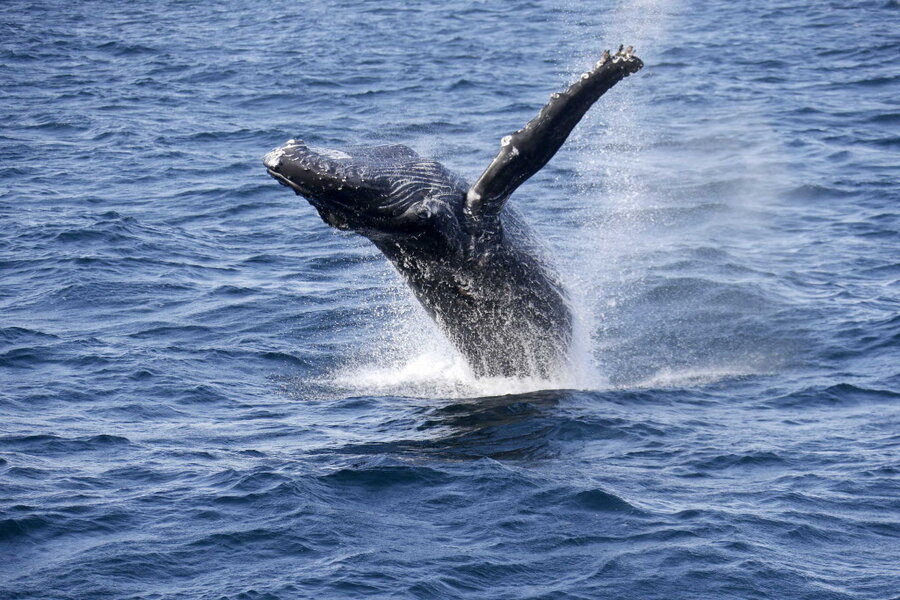An unwanted catch: Conservationists refocus to save the whales.
Loading...
When the International Whaling Commission (IWC) was founded in 1946, commercial hunting was the most significant threat to whale populations. But when the commission passed a whaling moratorium in 1982, the threat changed.
Bycatch is now the No. 1 killer of cetaceans, responsible for the death-by-entanglement of more than 300,000 whales and dolphins each year. Some say the IWC, one of the oldest international environmental organizations in history, hasn’t kept pace with the problem.
At the commission’s 70th annual meeting in Slovenia, the World Wildlife Fund (WWF) proposed taking a more holistic approach to preventing bycatch. By refocusing those efforts, the group says, conservationists and fisheries could work together to protect threatened cetaceans.
“Certainly there are countries looking to increase their whaling, so we need to stay vigilant,” says Leigh Henry, senior policy advisor for wildlife conservation at WWF, in a phone interview with The Christian Science Monitor. “But bycatch far outstrips the threat of whaling at this time, and we need a global response to the issue.”
The IWC has made considerable strides in whale conservation when it comes to the effects of climate change and ocean noise. It has even enacted a few measures to prevent bycatch, most of them species-specific.
But a global threat warrants a global response, Ms. Henry says. It’s still unclear what that response might look like, but internal scientific expertise may position the IWC to lead it.
“We don’t have all the pieces together yet because the conversation hasn’t really started at that global level,” says Henry. “That’s what we’re trying to get IWC to drive.”
The WWF has called on the commission to collaborate with the UN’s Food and Agriculture Organization (FAO), as well as its subsidiary Committee on Fisheries (COFI), to develop management plans and “best practices” for preventing bycatch. The FAO has already achieved moderate success with seabirds and marine turtles.
But in order to find solutions that work for everybody, the committee will have to collaborate with fisheries that have traditionally resisted such efforts. The Marine Mammal Protection Act, though mostly considered a success, had some unintended economic side-effects when it was passed in 1972.
“The US had a very strong position about the encirclement of dolphins and tuna, pursuing fisheries in the eastern North Pacific,” Bruce Mate, director of the Marine Mammal Institute at Oregon State University, says in a phone interview with the Monitor. “Because we were strong about that, it basically pushed [fisheries] completely out of the United States. I think that was very, very unfortunate.”
Despite pushback, there is an incentive for commercial fishing operations to reduce bycatch. The entanglement of large marine mammals often causes damage to expensive fishing gear – an additional financial burden for an industry that is already struggling.
“In some areas, the fishing community has been one of the best advocates for bycatch reduction,” says Henry. “When fishing practices are done in such a way that they minimize bycatch of marine turtles, marine mammals, and sharks, it can actually increase fishing productivity.”
To that end, fisheries already have models to draw from. The US now requires that most shrimp trawls come equipped with a “turtle excluder device,” or TED. These metal grates are heavy enough to keep shrimp in, but light enough for turtles to push through. In many cases, the device reduces turtle bycatch by over 90 percent.
Other fisheries have achieved success simply by implementing different types of hooks. New research finds that circle-shaped hooks, rather than the usual J-shaped hook, may prevent turtle bycatch without affecting intended catch.
Acoustic "pingers" on fishing nets may also ward off unwitting cetaceans. That may be good news for the vaquita, a highly endangered porpoise endemic to the upper Gulf of California, which may drown accidentally in gill nets set for fish.
“We have tools, and the tools will vary across fisheries and species,” Henry says. “But there’s not enough legislation, or mandate, or incentive to put those into practice across the board. And that’s what we really need to work on.”








